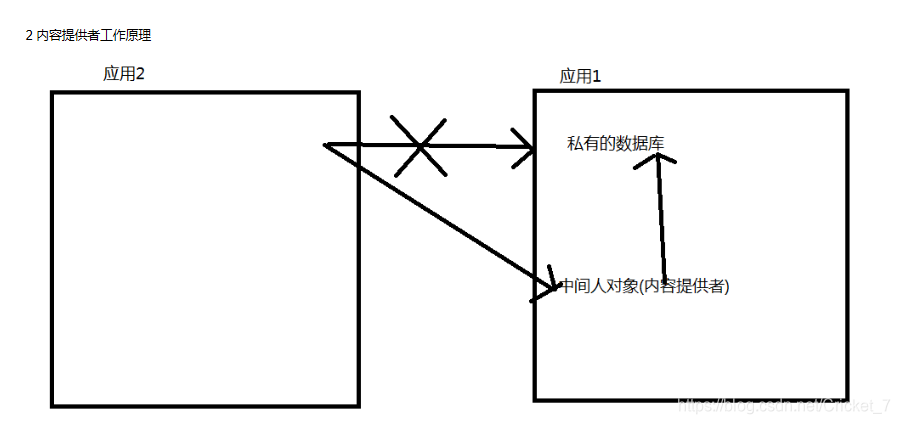Android 四大元件 ————ContenProvider(內容提供者)
阿新 • • 發佈:2018-12-14
1,介紹:
內容提供者(Content Provider) 主要用於在不同的應用程式之間實現資料共享的功能,它提供了一套完整的機制,允許一個程式訪問另一個程式的資料,同時還能保證被訪資料的安全性。
2,簡單原理圖
3,程序間訪問對方資料庫:
【1】在A程序中建立資料庫
public class MyOpenHelper extends SQLiteOpenHelper { /** * @param context * name :資料庫名字 * factory: 遊標工廠 * version: 資料庫的版本 */ public MyOpenHelper(Context context) { super(context, "account.db", null, 1); } //Called when the database is created for the first time. 當資料庫第一次建立的時候呼叫 那麼這個方法適合做表結構的初始化 @Override public void onCreate(SQLiteDatabase db) { db.execSQL("create table info (_id integer primary key autoincrement,name varchar(20),phone varchar(20),money varchar(20))"); db.execSQL("insert into info ('name','phone','money') values ('張三','138888','2000')"); db.execSQL("insert into info ('name','phone','money') values ('李四','139999','5000')"); } @Override public void onUpgrade(SQLiteDatabase db, int oldVersion, int newVersion) { } }
【2】Mian 方法中獲取資料庫例項,然後查詢當前資料庫訪問自己
public class MainActivity extends Activity { @Override protected void onCreate(Bundle savedInstanceState) { super.onCreate(savedInstanceState); setContentView(R.layout.activity_main); //[1]獲取MyOpenHelper例項 MyOpenHelper myOpenHelper = new MyOpenHelper(getApplicationContext()); //[2]建立資料庫 代表當前資料庫的物件 SQLiteDatabase db = myOpenHelper.getReadableDatabase(); //[3]把張三和李四的資訊讀取出來 Cursor cursor = db.query("info", null, null, null, null, null, null); if (cursor!=null && cursor.getCount()>0) { //[4]★ 想取出資料必須移動遊標 while(cursor.moveToNext()){ String name = cursor.getString(1); String money = cursor.getString(3); System.out.println("name:"+name+"----"+money); } } } }
【3】 在A程序中內容提供者暴露出來資料。
import android.content.ContentProvider; import android.content.ContentValues; import android.content.UriMatcher; import android.database.Cursor; import android.database.sqlite.SQLiteDatabase; import android.net.Uri; public class AccountProvider extends ContentProvider { // [1]定義一個urimatcher路徑匹配器 private static final UriMatcher sURIMatcher = new UriMatcher( UriMatcher.NO_MATCH); private static final int QUERYSUCESS = 0; private static final int INSERTSUCESS = 1; private static final int UPDATESUCESS = 2; private static final int DELETESUCESS = 3; private MyOpenHelper myOpenHelper; // [2]在靜態程式碼塊中新增路徑 static { /** * authority:要和你在清單檔案裡面宣告authority一樣 * * URL:統一資源定位符 https://www.baidu.com/tieba Uri:統一資源識別符號 * com.xiaoshuai.db/query uri就是自己定義的一個路徑 代表一個含義 * */ sURIMatcher.addURI("com.xiaoshuai.db", "query", QUERYSUCESS); sURIMatcher.addURI("com.xiaoshuai.db", "insert", INSERTSUCESS); sURIMatcher.addURI("com.xiaoshuai.db", "update", UPDATESUCESS); sURIMatcher.addURI("com.xiaoshuai.db", "delete", DELETESUCESS); } @Override public boolean onCreate() { myOpenHelper = new MyOpenHelper(getContext()); return false; } // 把這個方法對外暴露出去 @Override public Cursor query(Uri uri, String[] projection, String selection, String[] selectionArgs, String sortOrder) { // [1]獲取一個匹配碼 int code = sURIMatcher.match(uri); if (code == QUERYSUCESS) { // 說明路徑匹配成功 把這個方法實現 實際上就是在這個方法對資料庫進行查詢的操作 SQLiteDatabase db = myOpenHelper.getReadableDatabase(); Cursor cursor = db.query("info", projection, selection, selectionArgs, null, null, sortOrder); return cursor; } else { // 代表路徑匹配失敗 return null; // throw new IllegalArgumentException("哥們路徑不正確 ,請檢查路徑"); } } @Override public String getType(Uri uri) { return null; } @Override public Uri insert(Uri uri, ContentValues values) { int code = sURIMatcher.match(uri); if (code == INSERTSUCESS) { // 代表路徑匹配成功 把insert方法實現 SQLiteDatabase db = myOpenHelper.getReadableDatabase(); // 代表新插入行的id long insert = db.insert("info", null, values); Uri uri2 = Uri.parse("com.xiaoshuai.insert/" + insert); return uri2; } else { return null; } } @Override public int delete(Uri uri, String selection, String[] selectionArgs) { int code = sURIMatcher.match(uri); if (code == DELETESUCESS) { // 代表路徑匹配成功 把insert方法實現 SQLiteDatabase db = myOpenHelper.getReadableDatabase(); // 代表刪除的行數 int delete = db.delete("info", selection, selectionArgs); return delete; } else { return 0; } } @Override public int update(Uri uri, ContentValues values, String selection, String[] selectionArgs) { int code = sURIMatcher.match(uri); if (code == UPDATESUCESS) { // 代表路徑匹配成功 把insert方法實現 SQLiteDatabase db = myOpenHelper.getReadableDatabase(); // 代表更新的行數 int update = db.update("info", values, selection, selectionArgs); return update; } else { return 0; } } }
【4】在Android Manifest裡面註冊
<provider
android:authorities="com.xiaoshuai.db"
android:exported="true"
android:name=".AccountProvider" />
【5】在另一個程序中訪問A程序的資料庫
// 點選按鈕往資料庫裡面插入一條資料
public void click1(View v) {
// [1]由於第一個應用的資料庫系統已經通過內容提供者暴露出來 所以可以直接通過內容解析者操作資料庫
Uri uri = Uri.parse("content://com.xiaoshuai.db/insert");
// [2]建立contentValues
ContentValues values = new ContentValues();
// 引數1 是表的列名:
values.put("name", "王五");
values.put("money", "100");
// [3]往資料庫裡面插入了一條資料
Uri insert = getContentResolver().insert(uri, values);
System.out.println("inset:::" + insert);
}
// 點選按鈕刪除資料庫的資料
public void click2(View v) {
// [1]由於第一個應用的資料庫系統已經通過內容提供者暴露出來 所以可以直接通過內容解析者操作資料庫
Uri uri = Uri.parse("content://com.xiaoshuai.db/delete");
int delete = getContentResolver().delete(uri, "name=?",
new String[] { "王五" });
Toast.makeText(getApplicationContext(), "刪除了" + delete + "行", 1).show();
}
// 點選修改一條記錄
public void click3(View v) {
Uri uri = Uri.parse("content://com.xiaoshuai.db/update");
ContentValues values = new ContentValues();
values.put("money", "10000");
int update = getContentResolver().update(uri, values, "name=?",
new String[] { "王五" });
Toast.makeText(getApplicationContext(), "修改了了" + update + "行", 1)
.show();
}
// 點選按鈕查詢資料庫
public void click4(View v) {
// 二由於第一個應用程式的資料庫已經通過內容提供者暴露出來 所以我使用內容解析者來獲取資料
Uri uri = Uri.parse("content://com.xiaoshuai.db/query");
Cursor cursor = getContentResolver().query(uri, null, null, null, null);
if (cursor != null && cursor.getCount() > 0) {
// ★★★ 想取出資料必須移動遊標
while (cursor.moveToNext()) {
String name = cursor.getString(1);
String money = cursor.getString(3);
System.out.println("第二個應用~~name:" + name + "----" + money);
}
}
}
